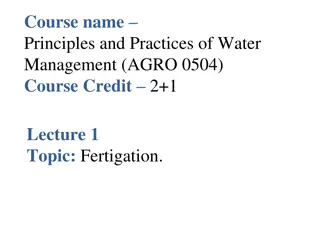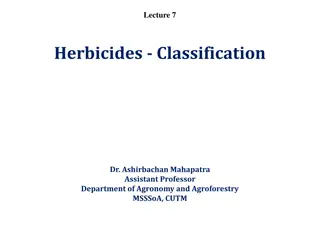The Role of Inorganic Nitrate in Preventing Contrast-Induced Nephropathy
Contrast-Induced Nephropathy (CIN) poses risks to patients undergoing angiography. This study evaluates the potential benefits of dietary inorganic nitrate in preventing CIN and its mechanisms. Results show promising renoprotective effects, highlighting a potential preventive approach for at-risk pa
1 views • 25 slides
Issues related to Fertilizers
The Department of Fertilizers discussed key issues related to fertilizers at the Kharif Conference 2023, focusing on promoting alternate fertilizers like nano urea and nano DAP, as well as initiatives such as PM Kisan Samrudhi Kendras and One Nation One Fertilizer. Detailed figures were presented on
0 views • 22 slides
Understanding Physiological Acid-Base Balance in Pharmaceutical Inorganic Chemistry
This lecture delves into the fundamental concepts of pharmaceutical inorganic chemistry, focusing on the mechanisms and uses of various pharmaceutical products that correct body disorders. Topics covered include acids and bases, intra and extracellular electrolytes, and the role of buffers in mainta
10 views • 14 slides
Overview of Herbicides Classification and Groups
Herbicides are classified based on their chemical nature into inorganic and organic types. Inorganic herbicides, such as arsenic acid and copper sulfate, do not contain carbon atoms, while organic herbicides, like glyphosate and 2,4-D, contain carbon atoms. The classification includes various groups
4 views • 15 slides
Insect Fertilizers Market Worth $319.7 Million by 2029
The fertilizers industry in Southeast Asia faced numerous challenges due to the COVID-19 pandemic, impacting the fertilizer distribution within and across markets in the Asia-Pacific region. Although lockdowns were imposed in Malaysia, fertilizer production facilities were given clearance to continu
5 views • 3 slides
Global Fertilizer Market
\n\nThe Global Fertilizer Market is expected to reach USD 254.87 billion by 2030, at a CAGR of 3.89% during the forecast period 2021 to 2030.
1 views • 3 slides
Understanding Minerals: A Comprehensive Guide
Earth's crust is composed of rocks made up of different minerals, which are naturally occurring, inorganic solids with distinct atomic structures and chemical compositions. Minerals exhibit properties like solidity, natural occurrence, inorganic nature, fixed composition, and crystal form. Identifyi
2 views • 20 slides
New UF Fertilization Certificate Program and Blueberry Soil pH Management
Explore the new UF Fertilization Certificate Program offering courses in fertilizer science and technology, focusing on soil pH management for blueberry nutrition. The program includes required and elective courses, field visits, and opportunities for scholarships/internships. Targeted towards gradu
0 views • 20 slides
Understanding Flame Photometry and Its Applications
A photoelectric flame photometer is utilized in inorganic chemical analysis to determine metal ion concentrations such as sodium, potassium, lithium, barium, and calcium. The photometer measures light intensity emitted when elements are exposed to a flame. By controlling flame color intensity, the d
1 views • 25 slides
Impact of Land-Use Consolidation Program on Farm Inputs in Rwanda
The study evaluates the effects of Rwanda's land-use consolidation program on farm input uptakes, specifically focusing on hybrid seeds, inorganic fertilizers, and pesticides. Results show significant increases in the adoption of hybrid seeds and inorganic fertilizers among participating households
0 views • 10 slides
Innovative Use of Sea Water in Drilling Fluid Development
This work focuses on leveraging sea water as an alternative to inorganic salts in drilling fluid formulations, reducing logistical costs and enhancing offshore operations. The development process involved scaling down additives to nano-size, aiming to create a product that not only replaces Lime in
1 views • 10 slides
Inorganic Pharmaceutical Chemistry: Applications and Importance
Inorganic pharmaceutical chemistry explores the study of elements and compounds excluding carbon, with diverse applications in pharmacy. It encompasses the synthesis and use of inorganic compounds in drug development, catalysis, pigments, and agriculture. The field also delves into the medicinal val
1 views • 6 slides
Understanding Fertilizers and Their Types
Fertilizers are essential for plant growth, providing nutrients necessary for healthy development. They are classified into organic and inorganic types, each with its own advantages and disadvantages. Organic fertilizers, sourced from natural materials like plants and animals, enrich the soil with o
2 views • 7 slides
Guidelines for Effective Management of Fertilizer Movement and Quality Control
Regular stock reconciliation, monitoring of dealer transactions, curbing hoarding practices, timely submission of subsidy claims, and strict quality control measures are essential for efficient management of fertilizer movement. Special emphasis on monitoring sales prices and ensuring compliance wit
0 views • 5 slides
Principles and Practices of Water Management: Fertigation System Overview
Fertigation, a fusion of "fertilizer" and "irrigation," revolutionizes crop cultivation by delivering complete fertilizer solutions to root zones through drip irrigation systems. This method, crucial in controlled environments like greenhouses and polyhouses, requires specific infrastructure, clean
0 views • 10 slides
Importance of Biofertilizer in Agriculture
Biofertilizers containing living microorganisms promote plant growth by enhancing nutrient availability. Blue-green algae, a type of biofertilizer, can fix atmospheric nitrogen to benefit crops. In agriculture, biofertilizers can help reduce chemical fertilizer use, restore soil health, and increase
0 views • 17 slides
Overview of Agricultural Subsidies in India
Government in India provides various subsidies to farmers, including fertilizer, power, irrigation, seed, export, credit, and agricultural infrastructure subsidies. The subsidies aim to support farmers with affordable inputs, stable prices, and adequate availability. The current subsidy bill is subs
0 views • 13 slides
Overview of Herbicides Classification and Chemical Nature
Herbicides are classified based on their chemical nature into inorganic and organic herbicides. Inorganic herbicides do not contain carbon atoms, while organic herbicides contain carbon atoms. They are further categorized into 31 classes, each with distinct properties and modes of action. This class
0 views • 15 slides
Understanding Angular Overlap Method in Advanced Inorganic Chemistry
Exploring the Angular Overlap Method (AOM) in advanced inorganic chemistry provides a qualitative discussion on the physical rationale behind the theory of complexes. By considering the interaction of atomic orbitals and the degree of overlap, AOM offers insights into energy quantification in coordi
0 views • 15 slides
Understanding Rodenticides: Types, Effects, and Treatment
Rodenticides are chemical preparations used for rodent control, primarily targeting mice and rats. They play a crucial role in managing rodent populations to prevent associated losses. The chapter covers an introduction to rodenticides, their classification into organic and inorganic types, mechanis
0 views • 19 slides
Exploring Bioinorganic Chemistry: Connecting Inorganic and Biochemistry
Bioinorganic Chemistry bridges the gap between inorganic chemistry and biochemistry, understanding the vital role of inorganic elements in living systems. This interdisciplinary field delves into the structure, function, and exploitation of metal ions in biological processes, emphasizing their inter
0 views • 47 slides
Overview of Wastewater Treatment Units and Processes
Screening units with screens and racks remove coarse solids, comminutors reduce the size of suspended solids, and grit chambers remove sand and metal fragments from wastewater to protect downstream equipment and processes. The floatation tank removes grease, while different designs of grit chambers
5 views • 15 slides
Coordination Numbers in Inorganic Compounds: Geometries and Structures
In inorganic coordination complexes, the coordination number refers to the number of atoms bonded to the central atom. Common geometries include octahedral, tetrahedral, and square planar, depending on the type and number of ligands. Transition metal complexes exhibit different coordination numbers
2 views • 8 slides
Isomerism in Inorganic Complexes: A Comprehensive Overview
Isomerism in inorganic complexes is a fascinating phenomenon arising from the specific spatial arrangements of atoms within molecules. This article delves into the types of isomerism found in coordination compounds, such as structural isomerism and stereoisomerism. The importance of studying isomers
0 views • 67 slides
Effect of Chicken Poop Fertilizer on Pumpkin Growth
Investigating the impact of chicken poop fertilizer on pumpkin growth, this study by Natalie Newell and Emily Gladney from Holy Trinity High School aims to determine if chicken poop is beneficial for pumpkins. The experiment explores whether using chicken poop as fertilizer enhances the growth of pu
0 views • 14 slides
Impact of Replacing Inorganic Zinc with Organic Zinc on Buffalo Calves
The study explores the effects of replacing inorganic zinc with a lower level of organic zinc (zinc propionate) on performance, biochemical constituents, and mineral status in buffalo calves. Zinc deficiency is a critical issue affecting growth, immunity, and reproduction in livestock. Inorganic min
0 views • 27 slides
Understanding the Fundamentals of Composting
Compost is organic matter decomposed into a valuable fertilizer and soil amendment. The process involves aerobic decomposition of waste material, turning it into nutrient-rich humus. Composting requires a mix of organic matter, water, air, and proper carbon:nitrogen ratio for efficient breakdown. Th
0 views • 21 slides
Linear Programming Models for Fertilizer Production, Metal Stamping, and Coffee Blending
The examples provide real-world scenarios requiring the formulation of linear programming models. The first involves the Kalo Fertilizer Company deciding on daily production quantities of two lawn fertilizer brands given resource constraints, costs, and demand. The second scenario explores the optim
0 views • 4 slides
Integrated Terrestrial-Coastal Ocean Framework for Carbon Management
An advanced framework integrating terrestrial and coastal ocean observations and modeling is developed to support carbon management decisions. The study focuses on assessing the impacts of land use, human activities, and climate scenarios on the carbon cycle, particularly dissolved inorganic carbon
0 views • 5 slides
Methods of Business Expansion and Key Terms Explained
Methods of business expansion can be organic or inorganic, with inorganic methods including strategic alliances, mergers, and takeovers. Key terms such as inorganic growth, joint ventures, acquisitions, and subsidiaries are crucial for understanding business expansion strategies.
0 views • 23 slides
Understanding Organic Chemistry and Macromolecules
Organic chemistry focuses on compounds with carbon bonds, while inorganic chemistry deals with other compounds. Carbon is unique due to its ability to form multiple bonds, creating diverse structures like chains and rings. Organic compounds, produced by living organisms, range from simple to complex
0 views • 32 slides
Insights into Fertilizer Cost Build-Up and Optimization Strategies
Explore the detailed cost breakdown of fertilizer pricing from import to retail in West Africa, uncovering the challenges and strategies to reduce costs. Discover the key factors influencing fertilizer prices, such as transportation, insurance, port charges, and more. Learn about optimizing costs th
0 views • 11 slides
EU Farm To Fork Strategy and COCERAL Impact Assessment
The European Commission proposes ambitious targets including transforming 10% of agricultural land for high diversity landscapes, increasing organic area to 25%, reducing fertilizer and pesticide use by 20% and 50% respectively. COCERAL's impact assessment aims to quantify the effects on the EU arab
0 views • 13 slides
Pesticide & Fertilizer Management Division Overview
The Pesticide & Fertilizer Management Division is a key state agency in Minnesota responsible for regulating pesticides and fertilizers, protecting groundwater, responding to emergencies, managing spills, and promoting agricultural water quality. The division works with farmers, industry stakeholder
0 views • 11 slides
Enhancing Nutrient Use and Manure Management for Sustainable Agriculture in Ghana
This study explores strategies to improve nutrient utilization and manure management in Ghana's agricultural systems. It discusses the sources of soil nutrients, reasons for low fertilizer use in Africa, ambitious targets set by the AU, and the impact of fertilizer subsidy programs in Ghana. Data on
0 views • 12 slides
Understanding Heterotrophic Nutrition in Organisms
Heterotrophic nutrition refers to the process where organisms, such as animals, rely on preformed organic molecules from their environment or other organisms for nutrients and energy. These organisms are unable to produce organic compounds from inorganic sources and must obtain nourishment from exte
0 views • 55 slides
Fertilizer Application and Cost Analysis for Soil Nutrients
This detailed agricultural analysis discusses the cost-effectiveness of applying anhydrous ammonia versus urea based on nitrogen content per pound, provides recommendations for nitrogen rates based on yield goals and soil analysis, calculates pounds of nutrients and fillers in a fertilizer blend, an
0 views • 7 slides
Agriculture and Fertilizer Business Insights in Uganda
Balton Uganda Limited, a subsidiary of Balton CP Group, operates in various Sub Saharan countries including Uganda. The company's departments cover Agriculture, Communication, Public Health, and more. The focus on Fertilizer Business in Uganda includes trends from 2011-2013, distribution channels, m
0 views • 19 slides
Analysis of Inorganic Fertilizer Supply Chain in Uganda
Examining the accessibility and quality of inorganic fertilizers in Uganda, the study focuses on key regions, targeted fertilizers, methodology, findings on moisture content and weight compliance, and implications for farmers. The research sheds light on challenges and opportunities in the country's
0 views • 17 slides
Essential Nutrients for Plant Tissue Cultures: A Comprehensive Guide
The composition of culture media for plant tissue cultures includes inorganic and organic nutrients, sources of energy like sucrose and amino acids, and essential macro and micronutrients. Providing gas exchange, waste removal, and growth regulators, the medium supports plant growth by offering acce
0 views • 22 slides







































